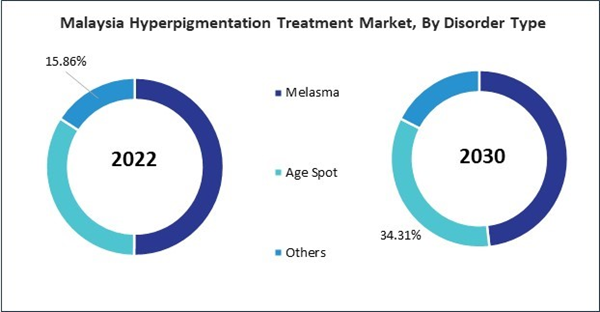The China market dominated the Asia Pacific Hyperpigmentation Treatment Market by Country in 2022, and would continue to be a dominant market till 2030; thereby, achieving a market value of $746.1 million by 2030. The Japan market is registering a CAGR of 8.2% during (2023 - 2030). Additionally, The India market would experience a CAGR of 9.6% during (2023 - 2030).
Hyperpigmentation treatments, including laser therapies and topical agents, diminish the appearance of these sun-induced pigmentations, restoring a more youthful and even complexion. Achieving an even skin tone is a common aesthetic goal for many individuals. Hyperpigmentation treatments, such as topical creams, serums, and laser therapies, help reduce the appearance of dark spots and blemishes, contributing to a smoother and more radiant complexion. Some hyperpigmentation treatments, particularly laser technologies, stimulate collagen production, improving skin texture. This can lead to smoother, more youthful-looking skin.
Laser-based hyperpigmentation treatments, such as laser tattoo removal, use targeted energy to break down pigmented particles in tattoos. This process helps fade and eventually eliminate the appearance of unwanted tattoos, catering to individuals seeking tattoo removal for personal or professional reasons. Hyperpigmentation can significantly impact an individual’s psychological well-being and self-esteem. Treating hyperpigmentation addresses physical concerns and improves confidence and self-worth, empowering individuals to feel better about their appearance. Hyperpigmentation treatments are not solely reactive but are increasingly used preventively. Individuals prone to hyperpigmentation, such as those with a history of melasma or sunspots, may incorporate topical agents and procedures into their skincare routines to prevent the development of new pigmentation issues.
According to Invest India, the growing middle-class population and rising disposable income will be important growth drivers for segments like premium beauty and personal care products, expected to grow by 54% between FY21-26. In addition, fragrances, makeup & cosmetics, and men’s grooming are all expected to expand by 20-40% between FY21-26. Therefore, due to the above-mentioned factors, the hyperpigmentation treatment market will grow significantly in this region.
Based on Treatment Type, the market is segmented into Topical Agent, Photo Therapy, and Microdermabrasion. Based on End User, the market is segmented into Dermatological Clinics, Hospitals, and Others. Based on Disorder Type, the market is segmented into Melasma, Age Spot, and Others. Based on countries, the market is segmented into China, Japan, India, South Korea, Singapore, Malaysia, and Rest of Asia Pacific.
List of Key Companies Profiled
- Vivier Pharma Inc.
- Pierre Fabre S.A
- Aerolase
- L'Oréal S.A.
- CP Skin Health Group, Inc. (The Colgate Palmolive Company)
- Trophy Skin Products LLC
- The Alchemee LLC (Taro Pharmaceutical Industries Ltd.)
- Episciences, Inc.
- The Procter and Gamble Company
- Galderma S.A.
Market Report Segmentation
By Treatment Type- Topical Agent
- Photo Therapy
- Microdermabrasion
- Dermatological Clinics
- Hospitals
- Others
- Melasma
- Age Spot
- Others
- China
- Japan
- India
- South Korea
- Singapore
- Malaysia
- Rest of Asia Pacific
Table of Contents
Companies Mentioned
- Vivier Pharma Inc.
- Pierre Fabre S.A
- Aerolase
- L'Oréal S.A.
- CP Skin Health Group, Inc. (The Colgate Palmolive Company)
- Trophy Skin Products LLC
- The Alchemee LLC (Taro Pharmaceutical Industries Ltd.)
- Episciences, Inc.
- The Procter and Gamble Company
- Galderma S.A.
Methodology

LOADING...









